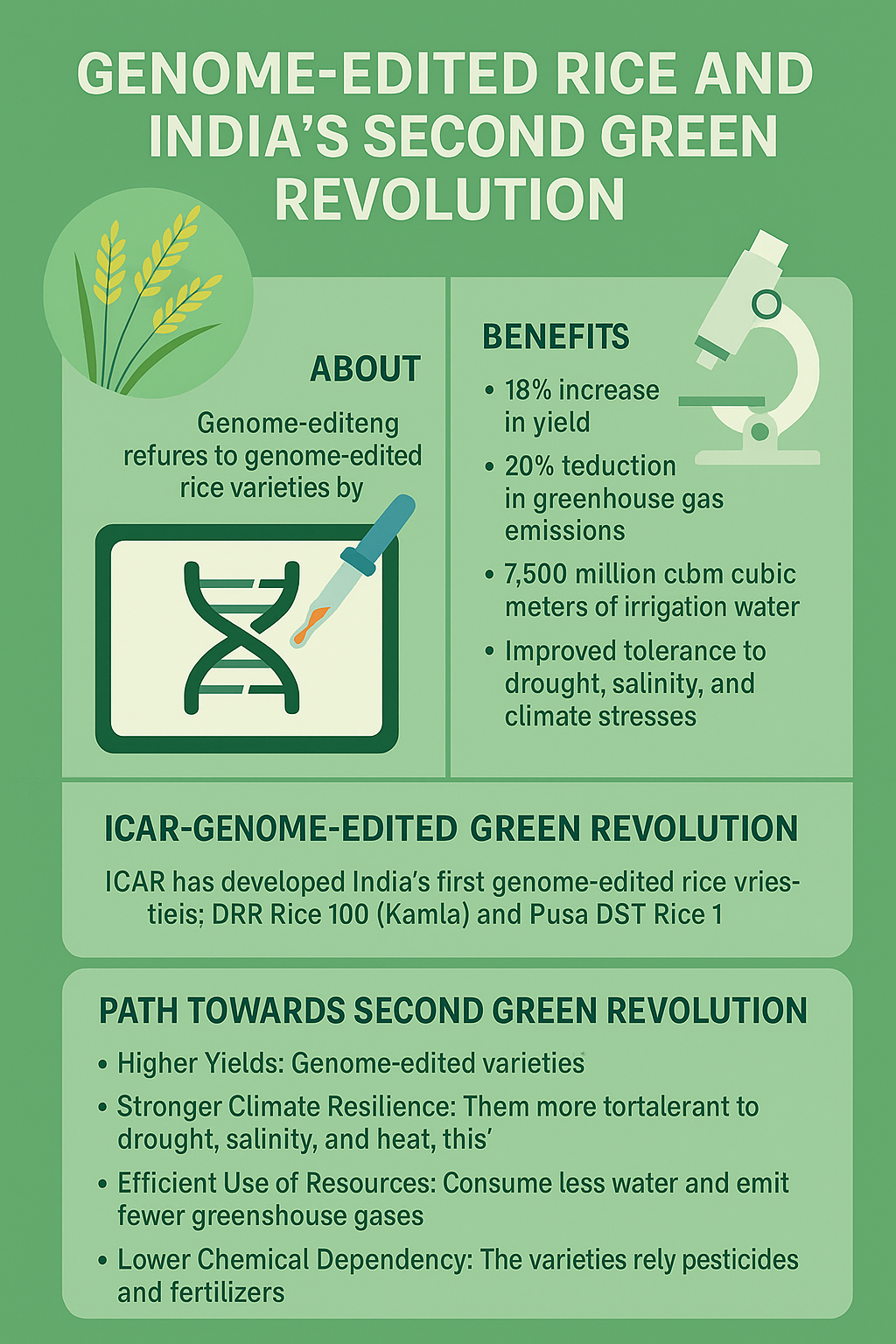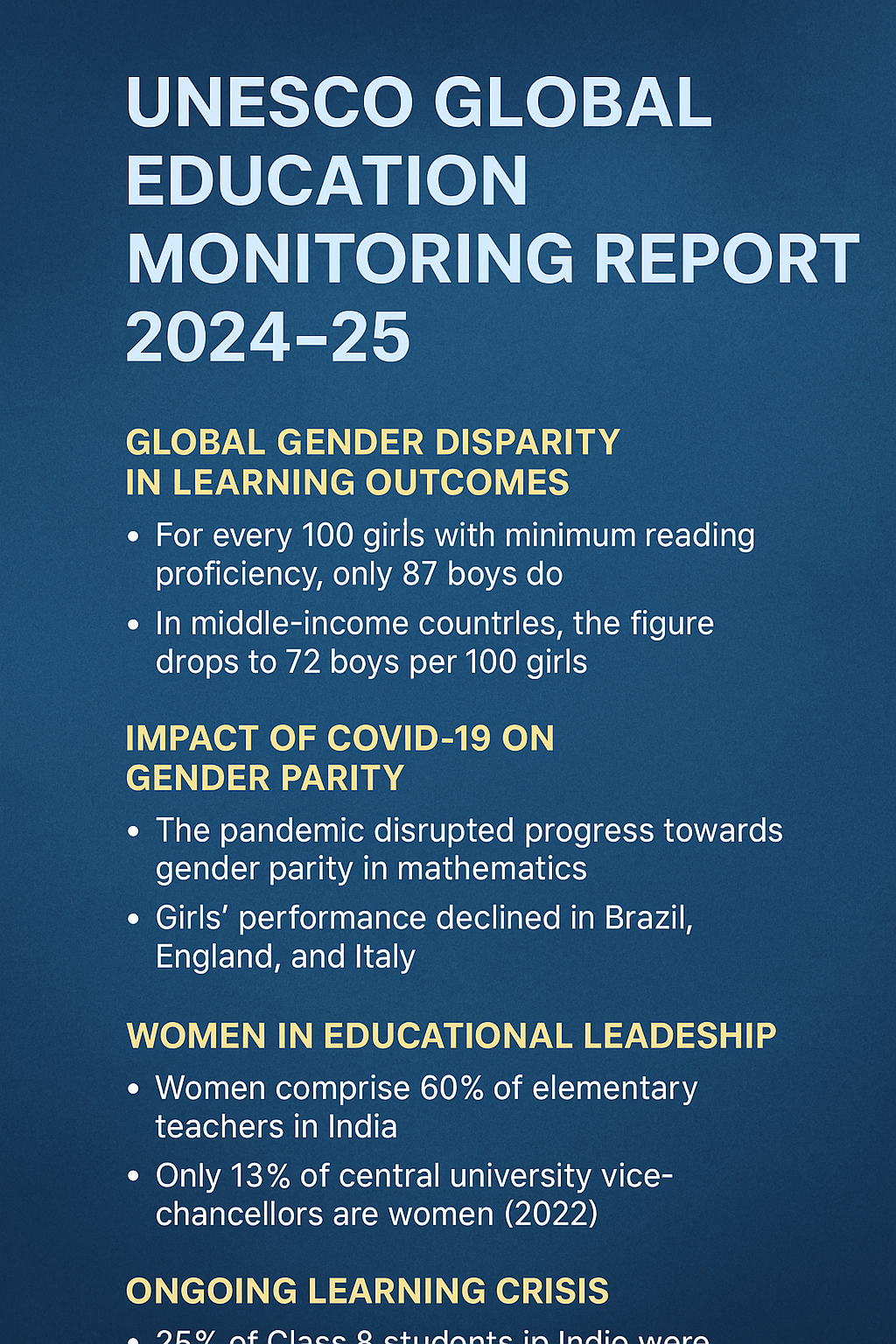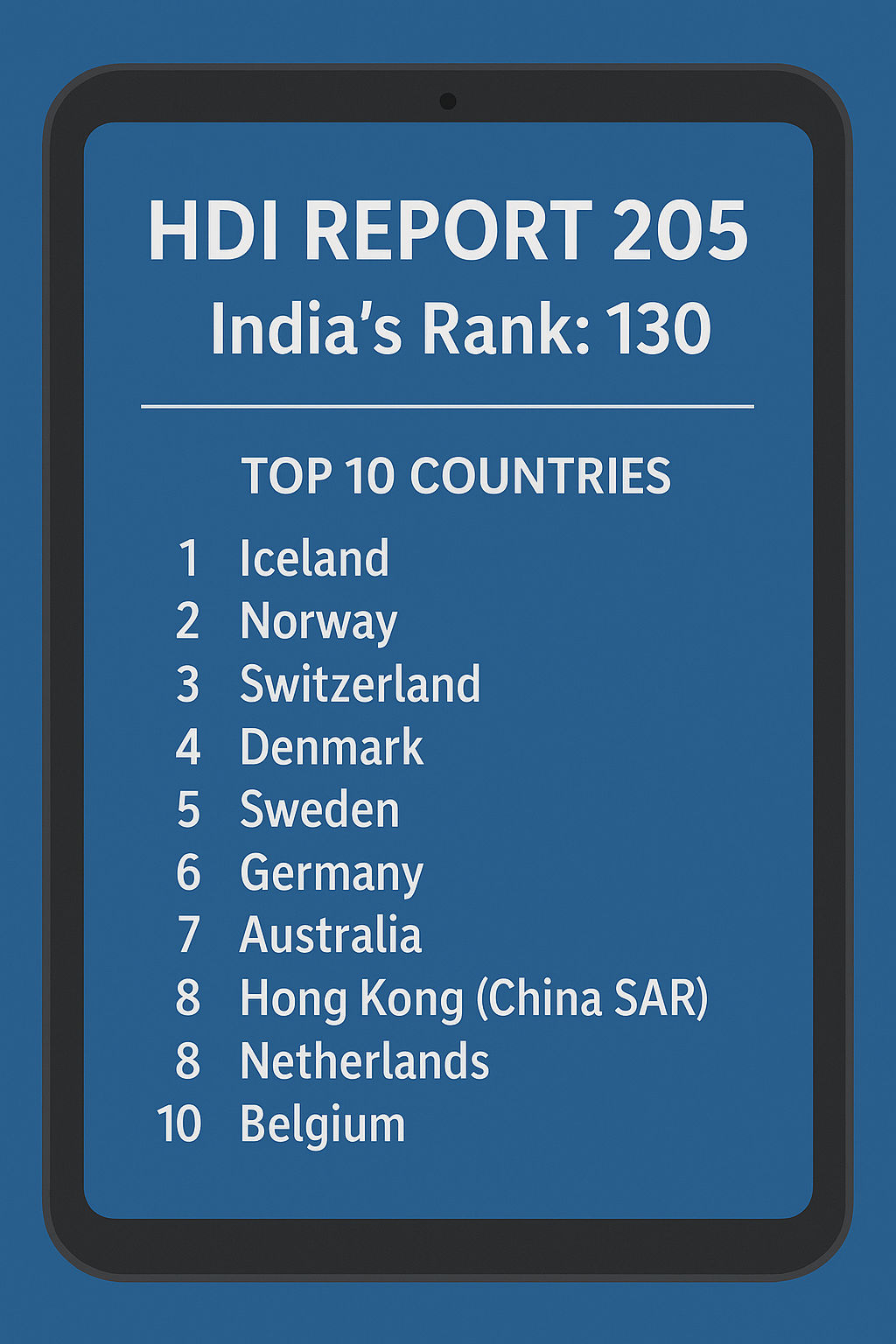
📅 May 5, 2025, Post 4: Seeds of Change: Genome-Edited Rice and India’s Second Green Revolution | Mains Essay Attached | Target IAS-26 MCQs Attached: A complete Package, Dear Aspirants!
Seeds of Change: Genome-Edited Rice and India’s Second Green Revolution

NATIONAL HERO — PETAL 004
🗓️ May 5, 2025
Thematic Focus: Agriculture 🌾 | Science & Technology 🧬 | Sustainability
🧬 Opening Whisper
The future of farming may no longer lie in the soil alone, but in the invisible strands of life re-coded by human hands.
Key Highlights
• The Union Agriculture Minister announced the launch of India’s first genome-edited rice varieties — DRR Rice 100 (Kamla) and Pusa DST Rice 1 — developed by ICAR using CRISPR-based genome-editing.
• This marks a potential Second Green Revolution, driven not by chemicals, but by precise genetic correction tools like CRISPR-Cas9.
• What is Genome Editing?
🔹 Genome editing allows precise changes in DNA without adding foreign genes — unlike GMOs.
🔹 CRISPR-Cas9 acts like molecular scissors, enabling scientists to cut, delete, or add DNA at precise locations.
• India allows the use of Site-Directed Nuclease (SDN)-1 and SDN-2 techniques in general crop development under biosafety norms.
• Benefits of the Genome-Edited Varieties:
🔹 19% higher yield
🔹 20% reduction in greenhouse gas emissions
🔹 7,500 million m³ water saved
🔹 Tolerance to drought, salinity, and climate stress
• These were developed under the National Agricultural Science Fund, focusing on improving Samba Mahsuri and MTU 1010 rice strains since 2018.
• Genome editing is also being extended to oilseeds and pulses, with ₹500 crore allocated in the 2023–24 Budget for such research.
🌿 Why It’s Being Called a Second Green Revolution
• Higher Yields: Like the 1960s revolution, these varieties dramatically improve productivity.
• Climate Resilience: Unlike water-intensive earlier crops, these are built for drought, salinity, and heat tolerance.
• Resource Efficiency: They save water and emit fewer greenhouse gases.
• Lower Chemical Dependency: Reduces pesticide and fertilizer use, thereby improving environmental sustainability and cutting costs.
🚨 Concerns and Ethical Dilemmas
• Export Barriers: Many countries lack clear policies on genome-edited crops, limiting India’s export potential.
• Corporate Control: Patents and licensing of genome-editing tools may increase dependency on agri-biotech companies.
• Biodiversity Risk: Overuse of limited high-performing varieties could shrink regional genetic diversity.
🧭 GS Paper Mapping
• GS Paper 3 – Science & Technology / Agriculture / Environment
🔹 Genome Editing, CRISPR, SDN-1, SDN-2
🔹 Sustainable Agriculture & Climate-Resilient Crops
🔹 Green Revolution 2.0
🔹 Biotechnology and Indian Food Security
• GS Paper 2 – Policy & Governance
🔹 Budget Allocation for Agri-Research
🔹 Regulatory Ethics & Public-Private Partnerships
💭 A Thought Spark — by IAS Monk
When we master the code of life with care, we must sow not just smarter seeds — but deeper wisdom. A second Green Revolution must feed not only the hungry stomach, but also the future.
High Quality Mains Essay For Practice :
Word Limit 1000-1200
“Achievements of the First Green Revolution and the Necessities of the Second”
Introduction: From Scarcity to Security, and Beyond
The story of independent India’s agricultural journey is one of transformation — from hunger to self-reliance, from imports to surpluses. At the heart of this change lies the First Green Revolution, a landmark scientific and policy breakthrough of the 1960s–70s that pulled India back from the brink of famine. But today, the very success of the Green Revolution poses a new challenge: can the methods that fed us now sustain us in an age of climate change, resource scarcity, and ecological fragility?
To answer this, we must assess the legacy of the First Green Revolution and understand why a Second Green Revolution — reimagined with sustainability, equity, and technology at its core — is not just desirable, but essential.
I. Achievements of the First Green Revolution: Sowing Self-Reliance
The First Green Revolution began in the 1960s under the leadership of scientists like M. S. Swaminathan and Norman Borlaug, with strong policy support from the Indian government. It introduced high-yielding varieties (HYVs) of wheat and rice, alongside improved irrigation, fertilizers, and pesticides.
✅ Major Achievements:
- Food Grain Self-Sufficiency:
- India’s wheat production rose from 10 million tonnes in the 1960s to over 100 million tonnes by 2020.
- India transformed from a food-deficient country dependent on PL-480 U.S. wheat imports to a net food exporter.
- Technological Breakthroughs:
- Adoption of HYV seeds, mechanization, synthetic fertilizers, and pesticides modernized Indian agriculture.
- Establishment of institutions like ICAR, agricultural universities, and Krishi Vigyan Kendras accelerated knowledge dissemination.
- Economic Stability and Rural Growth:
- Farm incomes rose in wheat-rich states like Punjab, Haryana, and western UP.
- It strengthened the rural economy, expanded rural employment, and contributed to India’s macro-economic resilience.
- Political Sovereignty:
- Self-sufficiency in food gave India strategic independence in international relations and reduced reliance on aid.
II. The Shadows of Success: Unintended Consequences of the First Green Revolution
While the revolution triumphed in quantity, it faltered in quality and sustainability.
❌ Environmental Degradation:
- Soil exhaustion from overuse of chemical fertilizers and monocropping.
- Groundwater depletion due to water-intensive rice and wheat.
- Rising greenhouse gas emissions from flooded paddy fields and diesel pumps.
❌ Regional Disparities:
- Benefits were concentrated in northwestern India; eastern and rainfed regions lagged.
- Dryland crops like millets, pulses, and oilseeds were neglected, hurting nutrition.
❌ Socio-economic Inequalities:
- Small and marginal farmers struggled to access credit, inputs, and technology.
- Tenant farmers and women were excluded from land and decision-making benefits.
The First Green Revolution addressed hunger — but it did not solve malnutrition, climate vulnerability, or inequality.
III. The Necessity of a Second Green Revolution: Why Now?
India is again at a turning point. The challenge is no longer just feeding people — it is feeding them nutritiously, equitably, and sustainably.
⚠️ The Context of Necessity:
- Climate change is causing erratic rainfall, extreme heat, and new pest patterns.
- Water scarcity threatens major agricultural belts.
- Nutritional insecurity persists, with India ranked poorly on global hunger indices.
- A young population and rising urban demand require reliable food systems.
- Global trade and export markets demand quality, safety, and traceability.
IV. Goals of the Second Green Revolution: Building Resilience and Regeneration
The Second Green Revolution cannot merely be a repetition — it must be a reimagination. Its objectives must include:
- Climate-Resilient Crops:
- Drought-, flood-, and salinity-tolerant varieties through genome editing (e.g., CRISPR).
- Focus on pulses, millets, oilseeds, and diversified crop baskets.
- Resource Efficiency:
- Precision farming, drip irrigation, and solar pumps to reduce water and energy use.
- Promotion of natural and organic farming methods.
- Nutrition-Centric Approach:
- Shift from calorie sufficiency to nutritional sufficiency.
- Biofortified crops, kitchen gardens, and diverse food systems.
- Equity and Inclusiveness:
- Empowering women farmers, smallholders, and tribal cultivators.
- Ensuring access to credit, extension services, and markets for all.
- Digital and Genomic Technology:
- Use of AI, drones, IoT, and blockchain in crop monitoring, logistics, and price discovery.
- Strengthening public-private partnerships for agri-innovation.
- Sustainable Supply Chains:
- Cold chains, farmer-producer organizations (FPOs), and direct market access to reduce post-harvest losses.
V. Policy and Institutional Reforms: Enablers of the Revolution
India is already laying foundations for this second wave through:
- PM-KUSUM: Promoting solar-powered irrigation.
- PM-PRANAM: Reducing chemical fertilizer use.
- ICAR’s Genome-Edited Rice Project: Launching climate-smart high-yield varieties.
- Budget Allocation (₹500 Cr): For genome editing research in agriculture.
- International Year of Millets (2023): Elevating neglected nutritious grains.
Yet, challenges remain — regulatory clarity, farmer awareness, landholding fragmentation, and data privacy in digital farming.
Conclusion: A Revolution Rooted in Responsibility
The Second Green Revolution must not only increase production — it must also heal the land, nourish the people, and empower the farmer. While the first revolution taught India to feed itself, the second must teach it to feed wisely and sustainably.
India’s future food story will not be written by yield charts alone, but by how gently it treads on soil, how fairly it treats its farmers, and how mindfully it cultivates hope.
Quote to End With
“The true measure of a nation’s development is not how much it produces, but how it feeds its poorest with dignity and balance.” — IAS Monk
Target IAS-26: Daily MCQs :
📌 Prelims Practice MCQs
Topic:
MCQ 1 – Type 1: How many of the following statements are correct?
Q. Consider the following statements regarding genome-edited crops and their significance in India:
• 1) Genome editing using CRISPR allows precise modifications without introducing foreign DNA, unlike traditional GMOs.
• 2) India permits genome editing using SDN-1 and SDN-2 techniques under its biosafety regulations.
• 3) The genome-edited rice varieties developed by ICAR show improved yield and reduced water usage.
• 4) India’s current policy bans all forms of genome-editing research in oilseeds and pulses.
Options:
A) Only two
B) Only three
C) All four
D) Only one
🌀 Didn’t get it? Click here (▸) for the Correct Answer & Explanation
✅ Correct Answer: B) Only three
🧠 Explanation:
• 1) ✅ Correct – CRISPR edits the genome without inserting foreign genes, distinguishing it from GMOs.
• 2) ✅ Correct – India permits genome editing using SDN-1 and SDN-2 methods under current biosafety guidelines.
• 3) ✅ Correct – ICAR’s genome-edited rice (e.g., DRR Rice 100) improves yield by 19% and reduces irrigation water demand.
• 4) ❌ Incorrect – India is actively funding genome-editing research in oilseeds and pulses (₹500 crore allocated in Budget 2023–24).
✅ Therefore, statements 1, 2, and 3 are correct.
MCQ 2 – Type 2: Two Statements Based
Q. Consider the following statements about the First and Second Green Revolutions in India:
• 1) The First Green Revolution prioritized food security through high-yielding wheat and rice but caused regional and ecological imbalances.
• 2) The Second Green Revolution focuses on nutritional security, resource efficiency, and climate-resilient agriculture.
Which of the above statements is/are correct?
A) Only 1 is correct
B) Only 2 is correct
C) Both are correct
D) Neither is correct
🌀 Didn’t get it? Click here (▸) for the Correct Answer & Explanation
✅ Correct Answer: C) Both are correct
🧠 Explanation:
• 1) ✅ Correct – The First Green Revolution boosted wheat and rice yields but was regionally skewed and environmentally intensive.
• 2) ✅ Correct – The new revolution aims at climate resilience, nutrition, and lowering chemical inputs through tech-driven approaches.
✅ Both statements are correct and capture the evolution of India’s agri-policy priorities.
MCQ 3 – Type 3: Which of the following statements is/are correct?
Q. Which of the following are features or goals of India’s Second Green Revolution?
• 1) Achieving higher yields through genome-edited and biofortified varieties
• 2) Reducing dependence on pesticides and fertilizers
• 3) Exporting surplus genetically modified food grains to global markets
• 4) Promoting climate-resilient crops like millets and pulses
Options:
A) 1, 2, and 4 only
B) 1, 3, and 4 only
C) 2 and 3 only
D) All four
🌀 Didn’t get it? Click here (▸) for the Correct Answer & Explanation
✅ Correct Answer: A) 1, 2, and 4 only
🧠 Explanation:
• 1) ✅ Correct – Genome editing is used for higher-yielding and climate-smart varieties.
• 2) ✅ Correct – One aim is to reduce chemical inputs and environmental harm.
• 3) ❌ Incorrect – India’s export potential is limited due to global regulatory uncertainty over genome-edited crops.
• 4) ✅ Correct – Millets, pulses, and oilseeds are central to this diversified, nutrition-sensitive revolution.
✅ Hence, 1, 2, and 4 are correct.
MCQ 4 – Type 4: Direct Fact
Q. Who is known as the ‘Father of the Indian Green Revolution’?
A) C. Subramaniam
B) M. S. Swaminathan
C) Norman Borlaug
D) Verghese Kurien
🌀 Didn’t get it? Click here (▸) for the Correct Answer & Explanation.
✅ Correct Answer: B) M. S. Swaminathan
🧠 Explanation:
• M. S. Swaminathan led the scientific initiative to introduce high-yielding wheat and rice varieties during the 1960s, making him the Father of India’s Green Revolution.
• Norman Borlaug, an American agronomist, is called the Father of the Global Green Revolution.
This is a frequently asked static factual question in UPSC Prelims.


















